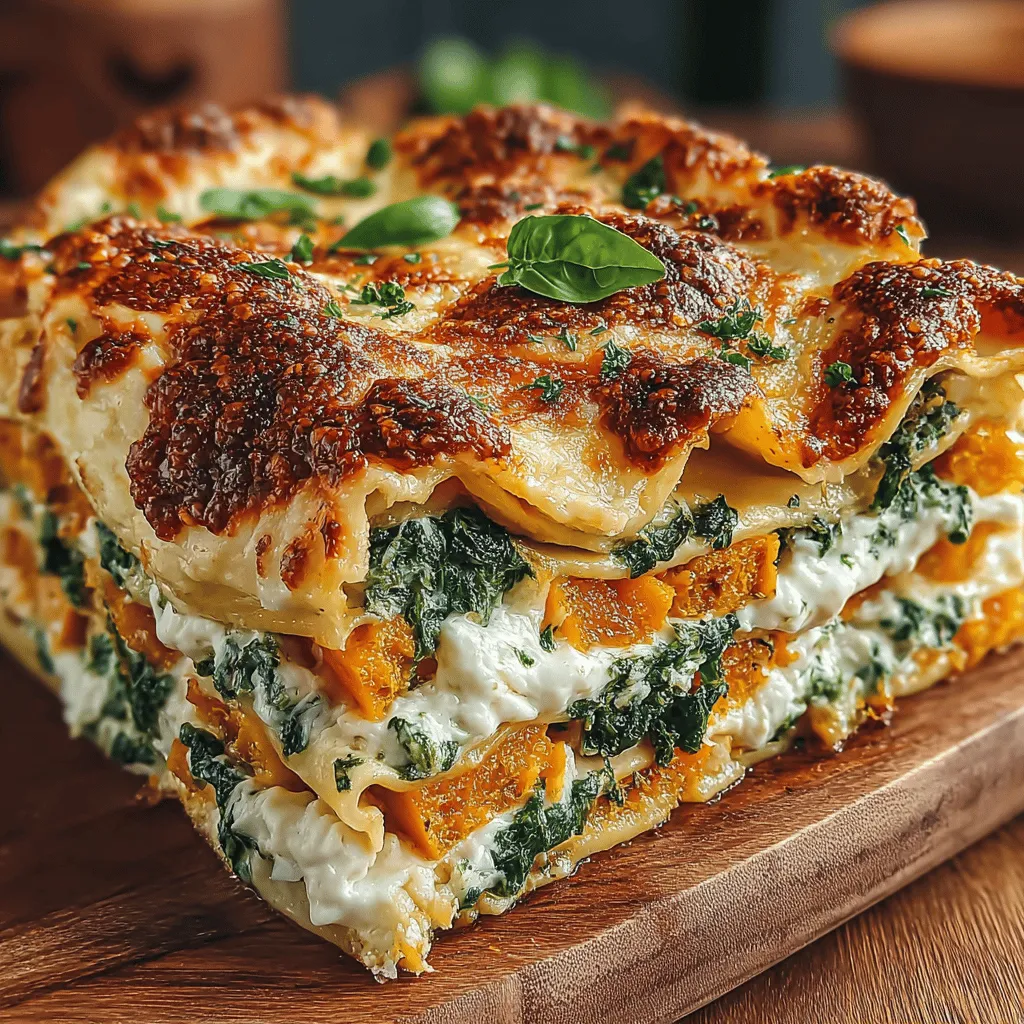Whimsical Butternut Squash Spinach Lasagna: A Comfort Food Delight
Lasagna has long been cherished as a quintessential comfort food, warming hearts and homes with its layers of rich flavors and hearty ingredients. This beloved dish, traditionally composed of pasta, sauce, and cheese, transcends culinary boundaries with its endless variations. In this rendition, we introduce a whimsical twist that combines the creamy sweetness of butternut squash with the earthy goodness of spinach. This Butternut Squash Spinach Lasagna not only tantalizes the taste buds but also packs a nutritious punch, making it an ideal choice for health-conscious eaters.
The allure of this lasagna lies in its versatility. Perfectly suited for vegetarians and adaptable for gluten-free dieters, this recipe invites everyone to the table. Whether you are seeking a comforting weeknight dinner or a stunning centerpiece for a special occasion, this lasagna promises to impress with its vibrant flavors and inviting presentation. Let’s delve into the unique ingredients that make this dish shine and explore the first steps of preparation.
Understanding the Ingredients
Butternut Squash
Butternut squash is the star of this lasagna, contributing a naturally sweet flavor and a creamy texture that elevates the dish. This winter squash is not only delicious but also packed with nutrients. Rich in vitamins A and C, potassium, and fiber, butternut squash promotes eye health, boosts the immune system, and aids in digestion.
When selecting butternut squash, look for one that feels heavy for its size and has a smooth, blemish-free skin. A dull, beige exterior indicates ripeness, while a shiny skin may suggest it’s under ripe. To prepare butternut squash, start by cutting off the stem and base, then slice it in half lengthwise. Scoop out the seeds and place the halves cut-side down on a baking sheet. Roasting the squash enhances its natural sweetness and deepens the flavor profile, making it a perfect filling for lasagna.
Spinach
Spinach is another key ingredient in this recipe, adding a burst of color and a wealth of health benefits. This leafy green is renowned for its high iron content, antioxidants, and vitamins, particularly vitamin K, which is essential for bone health. Spinach also contains folate, which is important for cell function and tissue growth.
When preparing this lasagna, you can choose between fresh and frozen spinach. Fresh spinach offers a vibrant flavor and a delightful texture, while frozen spinach can be a convenient option with a longer shelf life. If opting for frozen spinach, be sure to thaw and drain it thoroughly to avoid excess moisture in your lasagna.
Cheeses
No lasagna would be complete without a mix of flavorful cheeses that provide creaminess and depth. In this recipe, we use ricotta, mozzarella, and Parmesan cheeses. Ricotta brings a creamy richness and a mild flavor that complements the sweet butternut squash. Mozzarella adds a gooey, melty texture that binds the layers together, while Parmesan contributes a sharp, nutty flavor that enhances the overall taste profile.
Achieving a perfect balance of textures and flavors is crucial for a delicious lasagna. The creaminess of the ricotta, the stretchiness of the mozzarella, and the savory notes of the Parmesan create a harmonious blend that makes each bite irresistible.
Lasagna Noodles
When it comes to lasagna noodles, you have a couple of options to consider: traditional wheat noodles, whole wheat varieties, or gluten-free alternatives. Whole wheat noodles offer a nuttier flavor and added fiber, while gluten-free noodles accommodate those with dietary restrictions. Regardless of the type you choose, cooking them to al dente is essential for a successful lasagna. This ensures the noodles hold their shape and texture when layered with the filling and sauces.
To cook the noodles, bring a large pot of salted water to a boil. Add the noodles and cook according to package instructions, usually around 8 to 10 minutes. Be sure to stir occasionally to prevent sticking. Once cooked, drain the noodles and rinse them briefly under cold water to stop the cooking process. This will help maintain their firmness for layering.
Herbs and Spices
Herbs and spices are the unsung heroes of this lasagna, transforming simple ingredients into a flavorful masterpiece. The combination of garlic, oregano, nutmeg, salt, and pepper plays a crucial role in enhancing the overall taste. Garlic adds a fragrant aroma, while oregano introduces an earthy, slightly floral note that is synonymous with Italian cuisine. A pinch of nutmeg brings warmth and depth, perfectly complementing the sweetness of the butternut squash.
For an extra layer of flavor, consider incorporating fresh herbs like basil or thyme. These aromatic additions can elevate the dish and provide a burst of freshness that balances the richness of the cheeses and squash.
Step-by-Step Preparation Guide
Prepping the Oven and Ingredients
Before diving into the cooking process, it’s essential to preheat the oven to 375°F (190°C). Preheating ensures even cooking and helps achieve that coveted golden-brown top layer. While the oven warms up, take the time to prepare your ingredients.
Start with the butternut squash. As mentioned earlier, roast the squash for optimal flavor. Cut the squash in half, scoop out the seeds, and place it cut-side down on a baking sheet lined with parchment paper. Drizzle with olive oil, sprinkle with salt and pepper, and roast in the preheated oven for about 30-40 minutes, or until tender. Once roasted, allow it to cool slightly before scooping out the flesh for the filling.
While the squash is roasting, you can also prep your spinach. If using fresh spinach, rinse it thoroughly and remove any tough stems. For frozen spinach, allow it to thaw. Once thawed, be sure to squeeze out any excess moisture to prevent the lasagna from becoming soggy.
Cooking the Butternut Squash Mixture
With the butternut squash roasted and the spinach prepped, it’s time to bring the filling together. Start by heating a tablespoon of olive oil in a large skillet over medium heat. Add diced onions and sauté until they become translucent, about 5 minutes. The onions will release their natural sweetness, adding depth to the filling.
Next, add minced garlic to the skillet and cook for an additional minute, stirring frequently to prevent burning. The aroma of garlic will fill your kitchen, signaling that you’re on the right track. Once the garlic is fragrant, add the roasted butternut squash to the skillet. Use a fork or potato masher to mash the squash, leaving some chunks for texture. This will create a delightful filling that offers both creaminess and substance.
Stir in the prepared spinach and season the mixture with salt, pepper, and a pinch of nutmeg. Mix until the spinach is wilted and combined with the squash. This filling will serve as the heart of your lasagna, providing a nutritious and flavorful base for the layers ahead.
As you continue with the recipe, keep in mind that each step is important for building the flavors and textures that make this whimsical butternut squash spinach lasagna a true delight. With your filling ready, it’s almost time to assemble this comforting dish, but first, let’s explore the cheese layer and noodle assembly in the next part of this article.

Cooking the Lasagna Noodles
Cooking the lasagna noodles properly is a crucial step in achieving that delightful texture that complements the creamy filling and hearty layers of the whimsical butternut squash spinach lasagna. Here are some best practices to ensure your noodles are perfectly cooked:
Best Practices for Boiling Noodles and Preventing Sticking
1. Use a Large Pot: Always start with a large pot filled with generously salted water. The salt enhances the flavor of the noodles and helps prevent them from sticking together.
2. Bring to a Rolling Boil: Ensure the water is at a rolling boil before adding the lasagna noodles. This immediate heat helps to cook the noodles evenly.
3. Stir Frequently: As soon as you add the noodles, stir them gently. This action prevents them from sticking to each other or to the bottom of the pot.
4. Check for Al Dente: Boil the noodles according to the package instructions until they are al dente. This means they should be firm to the bite, as they will continue to cook when baked in the oven.
5. Rinse with Cold Water: After draining the noodles, rinse them briefly with cold water. This step halts the cooking process and helps prevent them from sticking together.
Alternatives for Those Who Prefer No-Boil Lasagna Noodles
If you prefer a quicker method, consider using no-boil lasagna noodles. These noodles are designed to absorb moisture from the sauce during baking, eliminating the need for pre-cooking. Simply layer them directly into your lasagna, ensuring that there is enough sauce to soften the noodles as they bake. This can save time and simplify the preparation while still yielding a delicious dish.
Creating the Cheese Filling
The cheese filling is the heart of any lasagna, and achieving the perfect creamy consistency is key. Here’s how to create a delectable cheese filling for your butternut squash spinach lasagna:
Mixing Tips for Achieving a Creamy Consistency
1. Choose the Right Cheese: For a rich filling, combine ricotta cheese with a blend of mozzarella and Parmesan. Ricotta provides creaminess, while mozzarella adds stretchiness, and Parmesan offers a sharp flavor.
2. Incorporate an Egg: Adding an egg to the cheese mixture can help bind the ingredients together and contribute to a creamy texture.
3. Mix Thoroughly: Use a fork or a spatula to mix the cheeses until smooth. Avoid over-mixing, as this can lead to a dense filling.
Flavoring Suggestions to Customize the Cheese Mixture
Boost the flavor of your cheese filling by incorporating fresh herbs, such as basil or parsley, along with garlic powder or fresh minced garlic. A pinch of nutmeg can also enhance the overall flavor profile, adding warmth and depth. Adjust the seasoning to your liking, and don’t hesitate to experiment with spices that excite your palate.
Assembling the Lasagna
With all components ready, it’s time to assemble the lasagna. This step requires attention to detail to ensure even distribution of flavors and textures.
Detailed Layering Technique for Even Distribution
1. Start with Sauce: Spread a thin layer of marinara sauce on the bottom of your baking dish. This prevents sticking and adds moisture.
2. First Layer of Noodles: Place a layer of noodles over the sauce, ensuring they don’t overlap too much.
3. Add Cheese Filling: Spoon a portion of the cheese mixture over the noodles, spreading it evenly with a spatula.
4. Layer the Vegetables: Next, add a layer of sautéed spinach and roasted butternut squash. Ensure the vegetables are evenly distributed.
5. Repeat: Continue layering with sauce, noodles, cheese, and vegetables until you reach the top of the dish. Finish with a final layer of noodles topped with marinara sauce and a generous sprinkle of mozzarella cheese.
Visual Cues to Recognize When Layers Are Properly Formed
Each layer should be visible but not overly thick. The goal is a balanced structure that allows the lasagna to hold its shape when sliced. Look for even distribution of color; you should see the golden squash, vibrant green spinach, and creamy cheese through each layer.
Baking the Lasagna
Baking the lasagna correctly is key to achieving that irresistible bubbly and golden topping.
Importance of Covering with Foil for the First Part of Baking
Cover the lasagna with aluminum foil for the first 30 minutes of baking. This helps keep the moisture in, allowing the noodles to cook through without drying out. Be careful not to let the foil touch the cheese, as this can cause it to stick.
How to Achieve a Perfectly Bubbly and Golden Cheese Topping
After the initial baking time, remove the foil and continue baking for an additional 15-20 minutes. This allows the cheese to become golden and bubbly. For an extra crispy top, consider broiling for a minute or two at the end, but keep a close eye to avoid burning.
Resting the Lasagna
Once the lasagna is out of the oven, it’s essential to let it rest before slicing.
Explanation of Why Resting is Crucial Before Slicing
Resting the lasagna allows the layers to set, making it easier to slice and serve. If you cut into it immediately, the layers may slide apart, resulting in a less appealing presentation. Let it rest for at least 15-20 minutes—this patience will reward you with beautiful, sturdy slices.
Suggestions for Serving and Presentation, Including Garnishing Options
When ready to serve, cut the lasagna into squares and plate them carefully. For an appealing presentation, sprinkle with fresh herbs like basil or parsley. A light drizzle of olive oil can add a lovely sheen and enhance the dish’s flavor. Pair with a crisp green salad and a light vinaigrette for a balanced meal.
Why This Lasagna is a Must-Try
Health Benefits
Incorporating vegetables like butternut squash and spinach into your lasagna not only enhances the flavor but also boosts its nutritional profile. Butternut squash is rich in vitamins A and C, potassium, and fiber, while spinach is packed with iron, calcium, and antioxidants. This colorful dish can be a part of a balanced diet, providing essential nutrients while satisfying your comfort food cravings.
Flavor Profile
The whimsical butternut squash spinach lasagna offers an exquisite balance of sweet and savory flavors. The sweetness of the roasted squash contrasts beautifully with the creamy cheese and tangy marinara sauce. The spices you choose, along with the fresh herbs, elevate the dish, creating a flavor experience that delights every palate.
Versatility of the Recipe
This lasagna recipe is incredibly versatile. If you’re vegetarian, you can easily keep it as is, or for added protein, consider adding cooked ground turkey or chicken. If you have dietary restrictions, gluten-free lasagna noodles can be used without compromising flavor. You can also substitute ricotta with a dairy-free option, making it suitable for vegan diets.
For side dishes, consider a simple arugula salad with lemon vinaigrette or garlic bread to complement the rich flavors of the lasagna.
Conclusion
The whimsical butternut squash spinach lasagna is not just a meal; it’s an experience. The process of creating this dish—from roasting the squash to layering the flavors—invites you into the kitchen and allows you to get creative. Whether it’s a family gathering or a cozy weeknight dinner, this lasagna is sure to impress.
Encourage yourself to embrace the joy of cooking and the satisfaction of sharing nutritious, homemade meals with loved ones. The delightful combination of flavors and textures makes this recipe a must-try that will become a staple in your household. So roll up your sleeves, gather your ingredients, and dive into the delightful world of lasagna-making!


